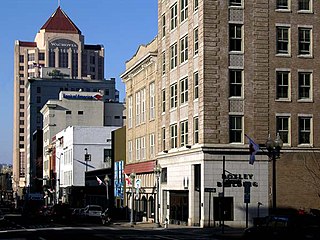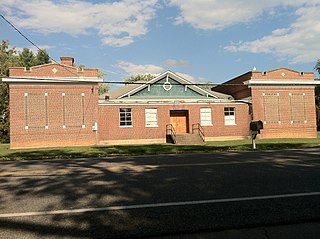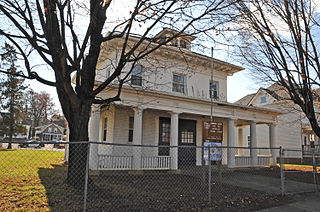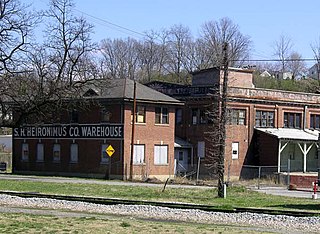
The Grandin Road Commercial Historic District, also referred to as Grandin Village, is a historic district listed on the National Register of Historic Places located in the Raleigh Court neighborhood of the independent city of Roanoke, Virginia, U.S.A. Centered at the intersection of Memorial Avenue and Grandin Road, Grandin Village has become one of the more eclectic areas of Roanoke, with an array of independently owned retail and dining establishments. The district has been noted as one of Roanoke's best examples of a mixed-use urban village, and has been used as a local model for future mixed-use developments within the community.

Prestwould is a historic house near Clarksville, Virginia. It is the most intact and best documented plantation surviving in Southside Virginia. The house was built by Sir Peyton Skipwith, 7th Baronet Skipwith, who moved his family from his Elm Hill Plantation to Prestwould in 1797. It was declared a National Historic Landmark in 2003. It is located on the north side of the Roanoke River, 1-mile (1.6 km) inland, approximately 6 miles (9.7 km) southwest of the intersection of Route 15 and Route 701, and approximately one mile north of Clarksville's town limits. Now a museum property, it is open for tours from April to October, or by appointment.
Hurt Park is a Roanoke, Virginia neighborhood located in central Roanoke between the Norfolk Southern railyard and the Roanoke River. It borders the neighborhoods of Cherry Hill on the west, West End on the east, Gilmer, Loudon-Melrose and Shenandoah West on the north across the Norfolk Southern railyard and Norwich across the Roanoke River and Mountain View on the south.

Mountain View is a Roanoke, Virginia neighborhood located in central Roanoke north of the Roanoke River. It borders the neighborhoods of Norwich on the west, West End on the east, Hurt Park on the north and Raleigh Court and Wasena on the south.

The Roanoke Downtown Historic District is a national historic district located in the Downtown Roanoke area of Roanoke, Virginia. It encompasses 122 contributing buildings. It includes a variety of commercial, institutional, social, and governmental buildings and structures from the late 19th century to the mid-20th century. Notable buildings include the Roanoke City Public Library, the YMCA Central Branch Building, First Christian Church (1925), the Central Church of the Brethren (1924), Tomnes Cawley Funeral Home (1928), Thomas B. Mason Building (1961), Peerless Candy Co., City Hall / Municipal Building (1915), Roanoke Times Building (1892), Anchor Building / Shenandoah Building (1910), Greene Memorial Methodist Church (1890), and United States Post Office and Courthouse (1930). Located in the district are the separately listed Patrick Henry Hotel, the Boxley Building, the Campbell Avenue Complex Historic District, Colonial National Bank, and First National Bank.

Roanoke City Market Historic District, also known as City Market District, is a national historic district located in the Downtown Roanoke area of Roanoke, Virginia.

Old Southwest is a neighborhood of the independent city of Roanoke, Virginia, United States. Located geographically near the center of the city, Old Southwest was annexed from Roanoke County in 1890 and developed as one of Roanoke's more affluent residential areas. Today the majority of the neighborhood falls within the Southwest Historic District listed on both the Virginia Landmarks Register and the National Register of Historic Places.

Starkey School is a historic school building located at Starkey, Roanoke County, Virginia. It was built about 1915, and is thought to incorporate an earlier one-room school built about 1894. It is a brick school building flanked by wings built in 1928, and measuring 24 feet by 33 feet. In December 1962, the school was closed and was purchased by Roanoke County. The school is now privately owned.

Harrison School is a historic public school building for African-American students located at Roanoke, Virginia. It was built in 1916, and is a three-story, brick public school building, with three-bay, two-story wings added in 1922. The original section consists of a 13-bay rectangular block flanked by projecting wings, five bays on the sides. The building symbolizes the pioneering efforts of Lucy Addison and other black educators in Southwest Virginia to offer academic secondary instruction to all children regardless of race.

Roanoke Warehouse Historic District, also known as 'Wholesale Row," is a national historic district located at Roanoke, Virginia. It encompasses five contributing buildings constructed between 1889 and 1902. All the buildings are constructed of brick, two-to-four stories in height and three-to-eleven bays in length. Two of the buildings have exceptional corbeled stepped gables in a Dutch-vernacular tradition. The buildings were erected for wholesale food storage.

Norfolk and Western Railway Company Historic District is a national historic district located at Roanoke, Virginia. It encompasses three contributing buildings constructed by the Norfolk and Western Railway. They are the Neoclassical Revival style General Office Building-South ; the Art Deco period General Office Building-North (1931); and the Moderne style Passenger Station. The Passenger Station was renovated by architect Raymond Loewy in 1949. The Passenger Station is occupied by the O. Winston Link Museum.

Henry Street Historic District is a national historic district located at Roanoke, Virginia. It encompasses four contributing buildings constructed between 1917 and 1951. They were developed as the central business and entertainment district for the African-American neighborhood of Gainsboro in Northwest Roanoke. They are the Hotel Dumas (1917), The Strand Theatre (1923), Dr. Lylburn Downing office, and a commercial building (1951).

Gainsboro Historic District is a national historic district located of Roanoke, Virginia. It encompasses 202 contributing buildings and 1 contributing structure in the African-American neighborhood of Gainsboro in Northwest Roanoke. They include single- and multiple-family dwellings, three churches; one parish hall, the Gainsboro Library, a theater, a hotel, two medical office buildings, six commercial buildings, one industry and one bridge. The buildings were primarily built between 1890 and 1925. Located in the district are the separately listed Gainsboro Branch of the Roanoke City Public Library and Henry Street Historic District.

Salem Avenue–Roanoke Automotive Commercial Historic District is a national historic district located of Roanoke, Virginia. It encompasses 59 contributing buildings in the southwestern part of the City of Roanoke. The district includes a variety of buildings having automotive, warehouse, light industrial and residential uses. Most of the buildings are small-scale, one or two-story brick or concrete block buildings, with the majority built between about 1920 and 1954. Notable buildings include the former Enfield Buick Dealership, Lindsay-Robinson & Co. Building (1918), Fulton Motor Company Auto Sales & Service (1928), Lacy Edgerton Motor Company, Roanoke Motor Car Company, and Fire Department No. 3 (1909).

Roanoke City Firehouse No. 6 is a historic fire station located in the Belmont neighborhood of Roanoke, Virginia. It was built in 1911, and is a two-story, three bay, hipped-roof building. It was built to resemble an early-20th century American Foursquare dwelling embellished with Classical Revival details.

Virginia Can Company-S.H. Heironimus Warehouse is a historic factory and warehouse complex located at Roanoke, Virginia. The "U"-shaped complex was built in 1912, and consists of an office and two factory buildings. All three of the buildings are two stories in height and are constructed of brick on a raised foundation of poured concrete. A second-story pedestrian bridge connects the two factory buildings and a brick hyphen connects the office building to the north factory building. The complex was built for the Virginia Can Company, the first and largest manufacturer of tin cans in Roanoke, Virginia. After 1951, it housed a clothing factory and then the Heironimus department store warehouse.

Old Roanoke County Courthouse is a historic courthouse building located at Salem, Virginia. It was built in 1909-1910 and is a three-story, Classical Revival-style, yellow brick building. The front facade features a three-story, tetra-style Ionic order portico. The courthouse has a hipped roof topped by a cupola, which is topped by an eagle. A rear addition was built in 1948–1949. Also on the property is the contributing 1910 Civil War Memorial, that consists of a granite shaft topped by the figure of a Confederate soldier. The building housed Roanoke County, Virginia county offices until they moved to a new building in 1985.

Salem Post Office, also known as the Old Post Office, is a historic post office building located at Salem, Virginia. It was built in 1922–1923, and is a one-story, Georgian Revival-style, brick building. It was designed by the Office of the Supervising Architect under the direction of Louis A. Simon. The main entrance features fluted Doric order pilasters surmounted by a Doric frieze with triglyphs and a dentilated pediment. Additions were made to the rear of the building in the 1950s, 1960s, and 1989–1991. The post office was decommissioned in 1985, and subsequently occupied by doctor's offices. In 2013, Roanoke College purchased the Old Post Office.

Downtown Salem Historic District is a national historic district located at Salem, Virginia. The district encompasses 34 contributing buildings and 1 contributing site in downtown Salem. The district includes primarily mixed-use commercial buildings, but also includes churches, dwellings, a courthouse, a post office, a library, a park, and the covered stalls of a farmer's market. The buildings mostly date from the late-19th and early-20th century and are in a variety of popular architectural styles including Greek Revival, Italianate, and Queen Anne. Notable buildings include the Stevens House or "Old Post House" (1820s-1830s), Kizer-Webber Building (1883-1886), Duval-Oakey House (1891-1898), Salem High School, Old Salem Municipal Building and Fire Department (1925), Quality Bakery Building, Olde Newberry Building (1929), Salem Theater, and James J. True Building (1927). Located in the district are the separately listed Old Roanoke County Courthouse, Salem Presbyterian Church, and Salem Post Office.

Fincastle Historic District is a national historic district located at Fincastle, Botetourt County, Virginia. It encompasses nine contributing buildings in the central business district of Fincastle. The district resources portray an excellent example of a typical small 19th century town. The buildings include examples of Late Victorian, Greek Revival, and Gothic Revival styles. Notable buildings include the Botetourt County Courthouse and jail, Methodist Church, Presbyterian Church, St. Mark's Episcopal Church (1837), the Peck House, Selander House, Ammen House, and Kyle House (1832).























